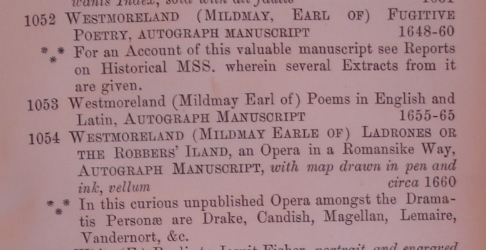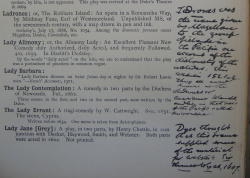Ladrones, or The Robbers' Island
Mildmay Fane, Earl of Westmoreland (1658)
Historical Records
 Detail of the Sotheby's auction catalogue (1887), p61 Courtesy of the Houghton Library |
The Sotheby's auction commencing 13 July 1887 included the following lot:
1054 WESTMORELAND (MILDMAY EARLE OF) LADRONES OR THE ROBBERS' ILAND, an Opera in a Romansike Way, AUTOGRAPH MANUSCRIPT, with map drawn in pen and ink, vellum circa 1660 ⁂ In this curious unpublished Opera amongst the Drama- tis Personæ are Drake, Candish, Magellan, Lemaire, Vandernort, &c.
Tom Cain notes that “[i]t was bought by Toovey for £3 3s, but has since vanished” (27). "Toovey" refers to either the bookseller James Toovey (1814-1893) or more likely his son, Charles (1848-1925), who took over his father's bookselling business at the 177 Piccadilly shopfront. Their trade stock was sold off following James's death, at another Sotheby's sale (February-March 1894). A private collection retained by Charles was acquired by J. Pierpoint Morgan in 1899. Regrettably, the Fane MS is not in the Morgan Library collection, and wasn't listed in the 1901 printed catalogue of books from the Toovey Collection purchased by Morgan in 1899 (Catalogue of a Collection of Books formed by James Toovey principally from the library of the Earl of Gosford / The property of J. PIERPONT MORGAN / New York 1901.).
Theatrical Provenance
Unknown.
Probable Genre(s)
Foreign history, recent history, voyage drama, operatic, historical fiction.
Possible Narrative and Dramatic Sources or Analogues
 Detail of Hazlitt's marginalia, p127 Courtesy of the Folger Shakespeare Library |
Harbage, possibly following Hazlitt rather than inspecting the Sotheby's catalogue himself, noted only that "Drake, Cavendish, and Magellan figure in the dramatis personae" (PMLA 690).
Inspection of the Sotheby's catalogue reveals two further characters in the play: Olivier van Noort (1558–1627) and Jacob Le Maire (1585–1616).
Accordingly, the drama was presumably an historical fiction; Ferdinand Magellan (c.1480-1521) set out on his circumnavigation of the world in 1519, Sir Francis Drake (1540–1596) circumnavigated the world in 1577-80, and Thomas Cavendish (c.1560-1592) completed his circumnavigation in 1585-88. In other words, the three men were never in the Ladrones at the same time (Magellan, indeed, was dead before the Englishmen were born; though possibly he may have played a spectral "ghost-of-Christmas-past" role in Fane's drama).
Magellan and the Ladrones
Hazlitt (127n, see image) notes in the marginal annotations of his personal copy of A manual for the collector and amateur of old English plays that:
Ladrones was the name given by Magellan to the group of islands in the Pacific on account of the dishonesty of the natives. This was in 1521-2. They are ever known as the Ladrones or Marianas Islands and lie in that part of the Pacific called Micronesia.
The story of Magellan's discovery and naming of the Ladrones is thus apparent; the experiences of Drake and Cavendish in this part of the Pacific are less clear.
Cavendish and the Ladrones
Francis Pretty's 1588 account (in Hakluyt 1599) tells us that Cavendish's fleet arrived at the Ladrones on 03 January 1588, where they traded with the "60 or 70 sailes of canoas full of Sauages, who came off to sea vnto vs, and brought with them in their boates plantans, cocos, potato rootes, and fresh fish, which they had caught at sea, and helde them vp vnto vs for to truck or exchange with vs" (1.817). Pretty relates that when the Englishmen had concluded their trade with the natives, "yet we could not be rid of them. For afterward they were so thicke about the ship, that it stemmed & brake 1 or 2 of their canoas" (817). The English resort to firing their "harquebuzes" (arquebuses; a muzzle-loaded firearm) at the natives, but with no obvious effect (the natives dove into the water) (1.818).
In 1613 Purchase alludes to Pretty's story in Hakluyt also:
they are best knowne, are knowne by the name of Theeues; a name fitting their nature and disposition. Thus did Magellane find them from whom (besides other things) they stole his boate, which by force he was forced to recouer. Such did our Countrey men in Maister Candishes renowned Voyage finde them, who saw also their Images of wood in the head of their boates, like the Images of the Deuill; Temple, and Saint, best fitting their devotions... (Purchase his pilgrimage 738)
Purchase reproduces Francis Pretty's account in the 1625 edition of Purchase his pilgrims.
Peter Heylyn provides a concise summary of the English knowledge of the islands in his Cosmographie (1652):
LOS LADRONES are certain Ilands situate betwixt the main Land of America and the Philippine Ilands, in the Longitude of 185. and the 4. Degree of Northern Latitude. So called by Magellanus who first discovered them, because of the thievishness of the Inhabitants, (Insulae Latronum is their name in Latine) who had stollen his Cock boat, which he was forced by main force to recover from them. And they continue still both their name and nature. Found such by Cavendish and Noert in their several Voyages, to whom they came under colour of buying Iron (a commodity which they highly prize) but either closely or openly stealing whatsoever they met with. The people tall of stature, brown of complexion, and inclining to corpulencie; extremely active, and good Divers, continuing a long time under the water, as if alike fitted to both Elements; insomuch as the Hollanders then with Noort, to make trial of it, cast five peeces of Iron into the Sea, all fetched out by one of them: The women as good at it as the men. Both Sexes given to filthy and promiscuous lusts; for which branded (many of them) with the marks of their incontinencie, the Pox having eaten off both their Lips and Noses.
Their Religion is worshipping the Devil, whose Images they have in wood on the head of their Boats; the Chappel and the Saint fit for such devotions. But for the nature of these Ilands, and what subjection the Inhabitants of it yield to the King of Spain, I am yet to seek. But like enough they yield as little as some others do, which yet are reckoned by our Authors to be parts of America. (178)
Drake and the Ladrones
Barely anything of note seems to have occurred concerning Drake and the Ladrones. After discovering and plundering California (which he named Nova Albion and claimed for Elizabeth I), Drake passed through the Ladrones en route back to England during his 1577-80 circumnavigation. His encounter appears to have been unremarkable, for it does not feature prominently in early modern accounts. The account in Hakluyt, for example, merely notes that after departing from Nova Albion,
He thought it not good to returne by the Streights, for two speciall causes: the one, least the Spaniards should there waite, and attend for him in great number and strength, whose handes he being left but one ship, could not possibly escape. The other cause was the dangerous situation of the mouth of the Streights of the South side, with continuall stormes raining and blushing, as he found by experience, besides the shoals and sands vpon the coast, wherefore he thought it not a good course to aduenture that way: he resolued therefore to auoide these hazards to goe forward to the Islands of the Malucos, and therehence to saile the course of the Portugales by the Cape of Bona Sperança. (Hakluyt 3.440)
van Noort and the Ladrones
The Dutch explorer Olivier van Noort circumnavigated the world between 1598-1601. His ships entered the Pacific in late February of 1600. Purchas tells us that van Noort's "chiefe Pilot was Captaine Melis, an Englishman, which had encompassed the Circumference with M. Thomas Candish" (Purchas his Pilgrimes, book 2, p71). Van Noort's encounter with the Ladrones is only mentioned briefly in Purchas:
On the fifteenth of September [1600], they had sight of the Ladrones. On the sixteenth, the Indians came in their Canoas, with Fish, Coquos, Bonnanas, Rootes, Sugar-canes, to barter for old pieces of yron: sometimes they might number two hundred of these Canoas, with two, three, or fiue men in each, all crying, Hiero, Hiero, that is, Yron, Yron, with greedinesse ouerturning their Canoas against the shippes side, which they regarded not, beeing expert swimmers, and could easily recouer their Boats, goods, and selues. They were subtile deceiuers, couering a Basket of Coquo shels, with a little Rice in the toppe, as if they had been full of Rice; and vpon fit opportunitie snatching a Sword out of the scabbard, and leaping into the Sea, where with deepe and long diuing, they secured themselues from shot. (Purchas his Pilgrimes, Book 2, 75)
Le Maire and the Ladrones
Jacob Le Maire was another Dutch mariner; he circumnavigated the world in 1615-16, and is best remembered for the strait named after him near Tierra del Fuego, as Peter Heylyn notes when he says of the Dutch, "For of this nation was Oliver de Noort, the fourth that compassed the world; Jacob le Maire, the first discoverer of the Straight, or Fretum, which now beareth his name; besides divers others. And generally the people are so expert in Navigation, (especially those bordering on or near the coasts) that they seem born for and to the seas" (Heylyn 5).
References to the Play
Only the Sotheby's catalogue.
Critical Commentary
In the context of Davenant's hybrid entertainments of the Interregnum ("part debate, part opera, part masque, and part play" [Clare 832]) whose generic form was a necessity, because it “enabled them to circumvent the prohibition of 1642, subsequently reinforced, on the presentation of plays” (Clare 832), McInnis argues that "Mildmay Fane, Earl of Westmoreland, appears to have taken a similar approach with a lost entertainment of his own," noting that the full title Ladrones or the Robbers’ Iland, an Opera in a Romansike Way suggests its similar incorporation of music, and thus generic hybridity (180n).
For What It's Worth
The Mariana (Marianas) Islands in the Pacific were known as the Ladrones, from the Spanish Islas de los Ladrones, Islands of Thieves.
Hazlitt's printed entry for the play (p127) reads:
Ladrones; or, The Robbers Island: An opera in a Romansike Way, by Mildmay Fane, Earl of Westmoreland. Unpublished MS. of the seventeenth century, with a map drawn in pen and ink.
- Sotheby’s, July 17, 1888, No. 1054. Among the dramatis personæ occur Magellan, Drake, Cavendish, etc.
This detail of the "map drawn in pen and ink" is noteworthy, and is not recorded in the other records listed in this entry.
Update (13 May 16): this detail can now be verified from the access provided in Historical Records above, to the Sotheby's catalogue.
Works Cited
Site created and maintained by David McInnis, University of Melbourne; updated 13 May 2016.